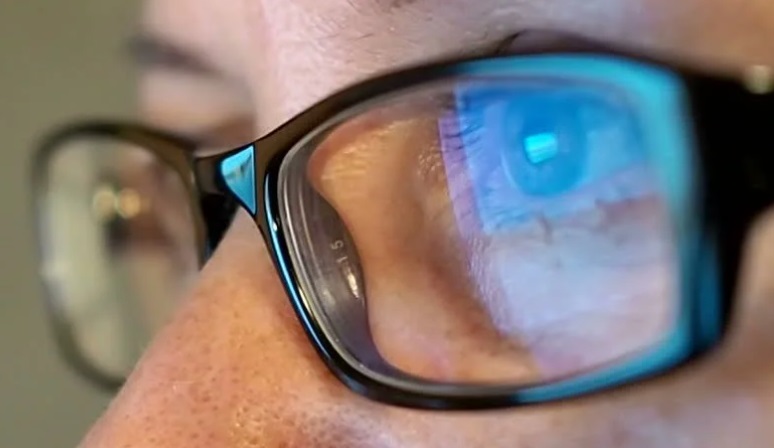In consonance with a retrospective analysis of antecedent investigations, the efficacy of blue-light-filtering eyewear in mitigating ocular strain and sleep disturbances appears to be tenuous.
The ubiquity of electronic displays has propelled blue-light-filtering spectacles into prominence, a countermeasure against the perpetual radiance emitted by these screens. This radiance, closely associated with ocular fatigue and somnolent disruptions, has metamorphosed into a sartorial endorsement, extolled by luminaries and cataloged in style manuals. Nonetheless, a recent scholarly critique casts doubt on the veracity of these spectacles’ efficacy.
The report, unveiled in the Cochrane Database of Systematic Reviews last week, delved into the repository of antecedent inquiries scrutinizing the ramifications of blue-light-filtering eyewear on ocular wellness, sleep caliber, and visual weariness. The scholarly cohort gleaned that the integration of blue-light filters does scant to ameliorate the ocular weariness stemming from computer usage. Ascertaining whether the employment of these bespoke lenses antecedent to slumber augments the quality of repose yielded equivocal findings.
Mark Rosenfield, a savant ensconced at the State University of New York College of Optometry, extricates a plaudit for this comprehensive appraisal. “The revelations strike no chord of astonishment…. A bevy of investigations have corroborated the selfsame, namely the dearth of substantiation validating the efficacy of blue-blocking lenses in alleviating ocular fatigue.” He further posits that despite their dedicated endorsement for said purpose, the potency of blue-blocking lenses in assuaging ocular fatigue rests bereft of any empirical vindication.
In sundry realms, inclusive of Australia, the United Kingdom, and India, studies unveil a preponderance of prescriptions for blue-light-filtering eyewear. About 75% of Australian optometrists, as surveyed by scholars from the University of Melbourne in 2019, endorsed blue-light-blocking eyewear in their clinical praxis. Laura Downie, co-author of the 2019 inquiry, and an associate professor of optometry and vision sciences at the University of Melbourne, resolved to scrutinize the veracity of prevailing research pertaining to the potency of eyewear in mitigating ocular fatigue, soporific disturbances, and visual debilitation resulting from digital apparatus usage.
OCULAR FATIGUE AND VISUAL WELLNESS
Laura Downie and her academic associates, for their latest scrutinization, culled 17 randomized controlled studies emanating from diverse geographical frontiers. These studies, spanning temporality from ephemeral durations to quintuple weeks, encompassed cohorts ranging from five to 156 participants. Relative to conventional limpid lenses, adorning blue-light-filtering eyewear with a view to alleviating visual fatigue evinced negligible transient amelioration, as posited by the evaluative inquisition. A solitary study pried into the effectuation of blue-light-filtering glasses on visual health, yielding marginal differentiation. With no enrolled investigation scrutinizing outcomes germane to retinal compromise, the inquisitors confronted an impasse in ascertaining the lenses’ implications on such afflictions.
Rosenfield vehemently contests the prevailing supposition that blue light fuels or exacerbates ocular fatigue. Sunlight remains the primary wellspring of blue light; digital screens emit a paltry fraction—lesser than 1%—of the blue light bequeathed by solar irradiance. Moreover, he posits that no physiological conduit correlates blue light with ocular weariness.
Downie posits that the strain stemming from protracted fixation on mobile or computer screens likely derives from multifarious etiologies, encompassing deleterious habits or latent pathologies. In unison, Downie and Rosenfield postulate that the predicament of ocular fatigue is more congruently affiliated with our relentless tether to digital contrivances, as opposed to the blue light they dispense. Downie advocates a dual pronged strategy involving the recalibration of the frequency and duration of computer utilization, coupled with a conscious divergence of ocular attention from the screens to mitigate discomfort. She accentuates the imperative of individuals besieged by ocular fatigue to seek medical consultation, facilitating an appraisal for underlying morbidities like hyperopia or xerophthalmia.
SOMNOLENCE MALAISE
Screen-induced exposure to azure radiance has indelibly linked with somnolence disruptions. Antecedent inquiries underscore the propensity of nocturnal device engagement to fray the fabric of slumber cycles, as propounded by Rosenfield. Melatonin, the hormone orchestrating the cadence of repose, has been identified as susceptible to disruption by the influence of azure light. Ergo, scholars have established an associative nexus between azure light and the aberration of circadian rhythms.
However, Downie’s coterie of researchers proffers a contrarian perspective, averring that preemptive inhibition of azure light before nocturnal repose might not bear the projected benefits. The confluence of outcomes arising from the sextuple experiments—encompassing the influence of blue-light-filtering eyewear antecedent to slumber on sleep quality—unveiled a schism. The intervention of blue-light-blocking eyewear engendered marked amelioration in sleep quality, as evidenced by three of the studies, while the trifling discernible variance between the blue-light-filtering cohort and the control cohort was manifest in the remaining triad of inquiries. Notably, the preponderance of subjects was besieged by somnolence maladies. With regard to the applicability of blue-light-filtering lenses to the adult populace, Downie and her fellow scholars found themselves precluded from attaining definitive resolutions.
Rosenfield propounds an auxiliary strategy for enhancing sleep quality—activating the “night shift” or “dark mode” functionality ubiquitous in myriad mobile devices. These settings engender a mellower palette of hues, mitigating glare and tempering the emission of azure light. However, it remains uncertain if this paradigm eclipses the utility of specialist eyewear in augmenting sleep efficacy.
To garner a more nuanced comprehension of the impact on ocular well-being, Rosenfield contends that an augmented corpus of research concerning azure light and its filtration is imperative. He cites the exigency of exploring whether discrete azure light wavelengths wield disproportionate deleterious potential, alluding to a need for further scholarship. Researchers may be aptly inclined to probe into enhanced iterations of blue-light-filtering eyewear.”
